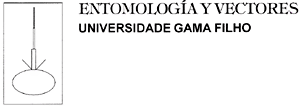The acrocerids (small headed-flies) form a small group of flies, which are difficult to find and observe. They are rare in collections. Their larvae are heteromorphic parasitoids of many families of spiders and their imagoes show a great deal of morphological variation. Little is known about the biology and systematics of this group in the Neotropical region, especially the Philopotinae. Most studies are based on species from Europe and North America. The Philopotinae occurs througout the world, and are characterized by the strongly developed postpronota, which form a shield dorsally in front of the scutum. Fifty specimens of Philopota sp. were collected from branches of Stachytarphetta cayenensis (Verbenaceae) in the Ilha da Marambaia (23º 04' S - 43º 53' W, 240 m), southern coast of Rio de Janeiro State, Brazil. The specimens were determined to Philopota n.sp. (acc. to Evert I. Schlinger). In Marambaia, S. cayenensis occurs alongside trails. Small lycosid spiders were observed associated with litter in the surrounding soil. Both males and females of Philopota n.sp. visit the flowers periodically. Couples in sexual intercourse were observed on the flowers. When feeding, they introduced their whole bodies inside the flower. A territorial behavior was observed involving both males and females. Up to four individuals were observed disputing a flower of S. cayenensis at the same time.
Philopotinae; Verbenaceae; Atlantic Rain Forest; hill-topping; Brazil

